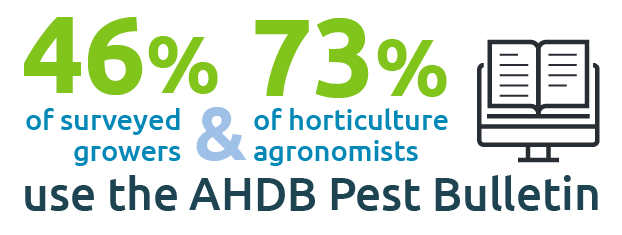Please click here to access the main AHDB website and other sectors.
- Home
- IPM in Horticulture - Biological pest control
IPM in Horticulture - Biological pest control
What is biological pest control? In its most simplistic form, biological pest control is the reduction or eradication of pest populations by natural enemies, which can either be encouraged to develop within the crop production system or artificially introduced. The term ‘pest’ not only refers to insects and mites, but also diseases and weeds, although its generally within the area of pest control where the commercial options are most advanced.
Control is achieved via a range of predators, parasitoids, and pathogens. Predators include lady birds, lacewings, ground beetles, various bugs and mites. They are active within crops and consume a large number of prey during their lifetime. Parasitoids include various wasps and flies whose immature stages develop on or within an insect host, leading to its death. The term pathogen is given to disease-causing organisms including bacteria, fungi, and viruses. They kill or debilitate their host and are relatively host specific.
Biological pest control is an important component of any integrated pest management strategy, along with appropriate varietal selection, implementation of cultural control measures, crop monitoring and forecasting and the use of bioprotectants (biopesticides) and compatible conventional pesticides.
Biological pest control in Horticulture
Biological pest control in its most extensive form can simply be the encouragement of beneficial organisms into a crop by a reduction in the use of broad-spectrum pesticides or via planting flowering plants adjacent to or within the crop to act as a food source for the adult beneficials. Often this is the approach adopted with field-grown crops. For protected crops, where the growing environment can be controlled, more intensive programmes can be implemented and a range of biological control agents can be purchased from commercial companies and introduced via a specific schedule. Whichever route is adopted, there is usually some element of human management involved at some stage in the process.

Principles underpinning any biological control programme
A successful biological pest control programme is not just about the selection and use of control agents or beneficials. Its first and foremost about the active facilitation of any introduction programme. Thought must be given in advance to the programme itself. What are the crops in question? What are the pests that need to be controlled? What are the prevailing temperatures? What production facilities are in place? How is the crop grown? What pesticides are used and have been applied recently? These questions need to be considered and addressed in advance as part of any programme.
Once a programme has been agreed upon, the biological control agents need to be introduced into the crop at the appropriate time, in sufficient numbers and in the correct manner. Most commercial products are offered in a form that makes this easier to implement. Biological control agents can be purchased in a carrier in bottles of various sizes, or for longer term release in sachets, stuck to cards, or impregnated in a medium. They can be sprinkled or blown into a crop, spot introduced via sachets or cards or drenched or sprayed. Depending on the agent in question, they need to be introduced close to, or within the crop, and applied away from direct sunlight or overhead irrigation.
Monitoring is key to the successful maintenance of any programme. Both pest and biological control agent/beneficial numbers should be monitored. Sticky traps will assist in the monitoring (and control) of pests. The correct colour, depending on the pest in question, needs to be selected. Traps should also be correctly positioned within crops at a density which is easy to manage, but provides sufficient detailed information about the spread of the pest within the crop. Crop scouting to check on both pest and control agent/beneficial numbers also needs to be employed and undertaken in the correct manner. The identification of ‘hot spots’, areas in the crop where the pest is more prevalent, is important to allow for early remedial action and the continued success of the programme.
Record keeping can feel mundane but is essential. The development of any pest within the crop needs to be monitored to provide an indication of the performance of any programme. When pest threshold levels are reached early action is paramount. Historic records also give an indication of the key pests likely to be an issue with the crops grown and the influence of season/prevailing weather conditions on previous programmes.
IPM in Horticulture Videos
Biological control agent selection
The use of any biological control agent will be determined by the pest in question. Some agents offer control of a wide range of pests, others can be specific down to the pest species level. Combinations of agents can work better and are often offered as commercial products. Prevailing temperatures and crop type, habit and development will also determine selection. Bear in mind not all agents can fly, so for those that walk they need to be distributed uniformly.
Resources to assist with your decisions
Over the years AHDB has produced a wide range of publications, tools and videos to assist with pest and disease control and also with the implementation and maintenance of biological control programmes. You can find these in our knowledge library or contact your Knowledge Exchange Manager for more information.
- Crop walker guides – these are the ‘go to’ guides developed for many horticultural crops which assist with the identification of pests, diseases and disorders, but also with the identification of biological control agents used in crops and beneficials that may be encountered.
- Factsheets – information on specific pests and diseases and their control can be found in a wide selection of factsheets for each sector.
- Posters – identification posters highlighting the key pests and diseases for numerous crops are available.
- Pest and disease forecasting/prediction tools
- Biological control and IPM videos





